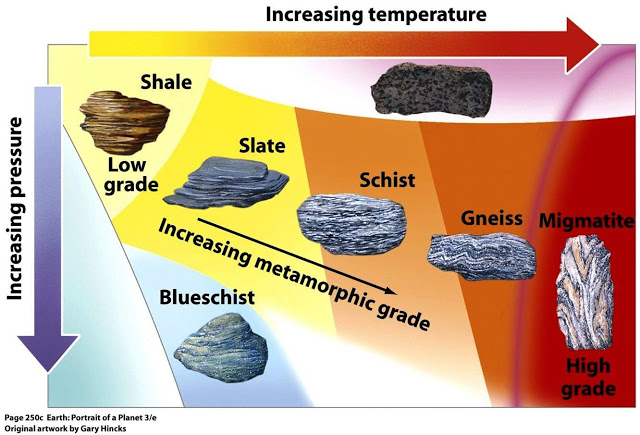
Week 3-4. Low grade and Ocean floor metamorphism
Introduction
Metamorphic grade is a general term for describing the relative temperature and pressure conditions under which metamorphic rocks form.
The degree or intensity of metamorphism that has affected a rock, is called grade of metamorphism .
Tilley has described as four types of grades
1. Very low grade, 2. Low grade, 3. Medium grade, 4 High grade.
Low-grade metamorphism takes place at temperatures between about 200 to 320oC, and relatively low pressure.
What is the difference between Low grade and High grade metamorphis?
Low-grade metamorphic rocks tend to be fine-grained (the newly formed metamorphic mineral grains ) while, High-grade metamorphic rocks tend to be coarse-grained. But grain size is also dependent on the grain size of the protolith.
Ocean-floor metamorphism: s a concept that has arisen from recent studies of present oceanic ridges and fracture zones where new crust is being generated, altered, and deformed. Recognition of on-land ophiolite suites as ancient examples of oceanic crust and mantle provide insights into the thermal and dynamothermal regimes that characterize ocean floors.
The ocean floor metamorphics are classified in four major categories:
(1) the zeolite facies
(2) the prehnite-pumpellyite facies
(3) the greenschist facies
(4) the amphibolite facies.
Within the metamorphic facies the term “mineral assemblage” is used when some of the secondary minerals formed suggest a metamorphic paragenesis. Three types of metamorphic regions have to be considered when dealing with the ocean floor:
(1) metamorphism that is associated with orogenetic belts and occurs at the convergence of lithospheric plates
(2) metamorphism that takes place along diverging plate boundaries associated with mid-oceanic ridges and fracture zones,
(3) metamorphism in intraplate regions. The theoretical approach to ocean floor metamorphic petrology is based on the principle of Eskola's metamorphic facies.
The concept of metamorphic facies as defined by Eskola refers to a group of rocks characterized by a set of minerals formed under a particular pressure and temperature condition. The mapping of subaerial terranes permits the recognition of new groups of metamorphic rocks and helps to infer the temperature of the metamorphic facies. The occurrence of metamorphism on diverging plate boundary regions suggests that the process of alteration started early in the history of the ocean floor. Some of the mineral associations found in metamorphosed basalts from recent spreading ridges are comparable to an equivalent alpine type of metamorphism. The study of the metamorphism of volcanics from the ocean floor associated with diverging plate-boundary regions has been focussed on the mid-oceanic provinces and fracture zones of both the Atlantic and the Indian Ocean.
Ocean-Floor Metamorphism affects the oceanic crust at ocean ridge spreading centers
• Considerable metasomatic alteration, notably loss of Ca and Si and gain of Mg and Na
• Highly altered chlorite-quartz rocks- distinctive high-Mg, low-Ca composition
• Exchange between basalt and hot seawater
• Another example of hydrothermal metamorphism



